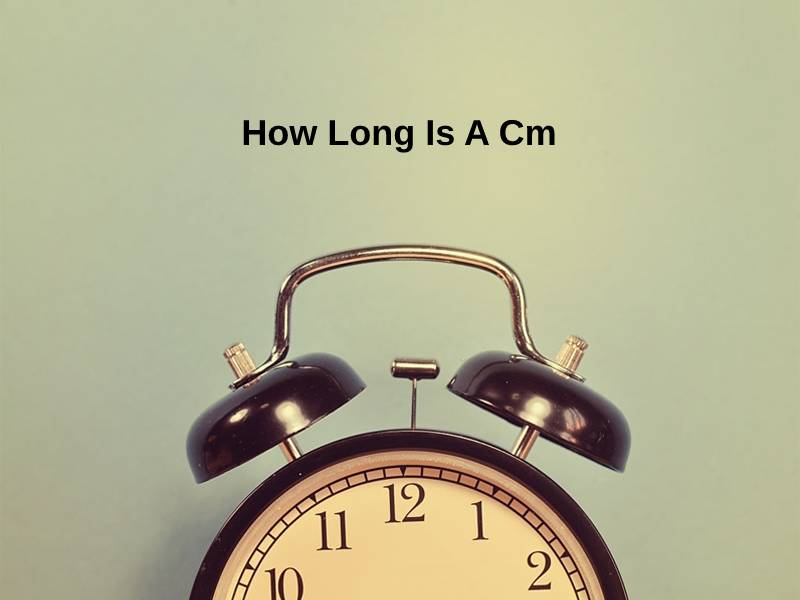Exact Answer: 0.01 meters
The metric system is a widely used system around the world. It uses units like a metre to measure length, a litre to measure the volume of liquids, and grams to measure solid volume. This is in contrast to the method used the United States Of America where units like feet, quarts, and ounces are in popular use.
When measuring length, the metre is the metric system of measurement. The centimetre is a fragment of a metre. When compared to the method used in the USA, known as the imperial method, the centimetre is comparable to the inches.

How Long Is A cm?
A metre cannot be used to measure all lengths. There can be very large distances between two cities and very small distances between two atoms. It is for this reason that the metre is divided and also enlarged to measure different distances.
Thus, the metre is based on 10s. There are units like centi-, kilo-, deca-, milli-, and nano- which are used as prefixed to the word metre to give a different value of measurement.
| Unit Of Measurement | Converted Unit Of Measurement |
| Metric System | Metric System |
| 1 centimetre | 0.01 metre |
| 1 centimetre | 1e – 5 kilometre |
| 1 centimetre | 10 millimetre |
| 1 centimetre | 10000 micrometre |
| 1 centimetre | 1e + 7 nanometre |
| Metric System | Other Systems |
| 1 centimetre | 6.2137e – 6 mile |
| 1 centimetre | 0.0109361 yard |
| 1 centimetre | 0.0328084 foot |
| 1 centimetre | 0.393701 inch |
| 1 centimetre | 5.3996e – 6 nautical miles |
A metre is the standard measure of measurement of length. This means that all other methods of length measurement in the metric system are related and stated in terms of metres. In terms of metres, a centimetre (commonly abbreviated as cm) is 0.01 metres. Conversely, one metre is the same as 100 centimetres.
However, when compared to other length measurement systems, a cm is equal to (6.2137e – 6) miles. Conversely, one mile is 160934 cm when converted to a centimetre.
When measured in terms of nautical miles, 1 cm is (5.3996e – 6) miles. When a cm is converted into inches, a cm is the same as 0.393701 inches. If the centimetre is converted into the foot, a cm measures 0.0328084 in terms of foot.
Why A cm Is That Long?
Since the metre is the standard unit to measure the length in the system, every other unit of measuring length is somehow, co-related with it. Thus, the value of each unit of length measurement in the metric system is either a fraction of it or a multiple of it.
If the value is in centimetres, one has to divide it by a hundred to get the equivalent value in metres. When the value is given is in centimetres, it can be multiplied by a hundred to get the corresponding value in metres.
However, when the value is given in kilograms, a person needs to multiply it by a hundred thousand. This will give an equivalent value of length in terms of centimetres. Moreover, to convert centimetres in kilograms, it can be multiplied by a hundred thousand.
However, it may also happen that one has to obtain the value of other non-metric units in centimetre terms. If the value is given is in inches of the imperial system of measurement, it needs to be multiplied by 2.54. Conversely, if the value provided is in centimetres, it can be divided by 2.54.
One must also have heard about nautical miles, which are used to measure the length of seas and oceans. If the value is in nautical miles, it can be multiplied by 185200 to get the equivalent measure of length in centimetres. A person can divide the length in centimetres by 185200 to get the desired length in nautical miles.
Conclusion
A centimetre is a sub-division of meters, (also spelt as a meter). It is a part of the metric system and its SI unit of measurement is cm. A centimetre is the one-hundredth fraction of a meter and fits this reason, one centimetre is equal to 0.01 meters.
Over the years, several formulas have been developed to establish the relationship between the metric system of measurements and the imperial system. This helps in the easy conversion of values and know exactly how long is a centimetre and the other value is in terms of a centimetre.